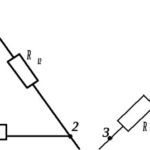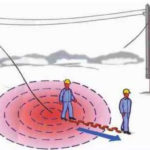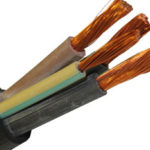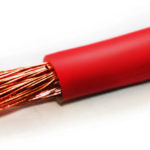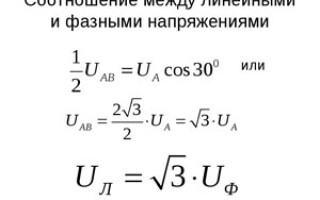The voltage level is a potential characteristic of the quality of electrical energy supply to consumers. The devices are operated for a long time provided that they operate in the permissible power range of the network. To determine the parameters of operation and connection, phase and linear voltage are distinguished in three-phase circuits. At the output from the manufacturer, the voltage is changed for transportation, and after the reverse conversion steps, it acquires the value used by consumers.
Content
What is a phase?
Phase is the value of a trigonometric function, such as defining a form or describing wave or vibrational motion. The value is identical to the angle or argument of the periodic function. The dependence of the whole phase on coordinates and time is not always linear and harmonic. The end of the conductor through which the current enters the circuit, or the clamp, represents the beginning of the phase.The change in the circuit voltage over time is the projection of the ray vector onto the coordinate axis.
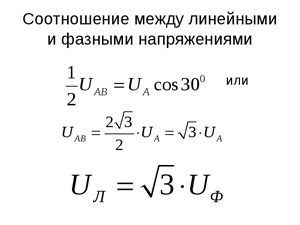
The circuit consists of standard elements - an energy generator, a transmission circuit, a receiver. For the concept of what a phase, linear voltage is, their interaction is required phase detection. The phase position is only valid for AC lines. The concept is defined as an equation of a sector of vector rotation with fixation of one end in the origin of coordinates.
Electric lines differ in the number of phases: one-, two-, three- and multi-phase.
In Russia, a three-phase network is popular for supplying consumers, which are represented by household buildings or industrial facilities. The connection has advantages compared to a single-phase power supply circuit:
- cost-effectiveness due to the beneficial use of materials;
- the ability to transport a large amount of electricity;
- inclusion in the working circuit of electric generators and high power engines;
- creation of different voltage indicators depending on the option of including the consuming load in the electric line.
Work in a three-phase circuit depends on the mutual ratio of its components. The voltage indicators depend on the phase (the angle of inclination of the vector beam to the coordinate plane of the axis). The voltage is determined by the ground potential, which is zero. Because of this, the cable with the voltage present is called phase, and the ground wire is called zero. The phase angle of the unit vector is of little importance, because in a line it makes a full 360° turn in 1/50 of a second. The interphase angle of relativity of 2 vectors is taken into account.
In a network using reactive parts, the angle is taken between the vector indicators of electric current and voltage, it is called phase shift. If the values of the connected loads do not change over time, then the amount of shift will always be constant. The invariance of the indicator is used in the calculation of the electric line and the analysis of work.
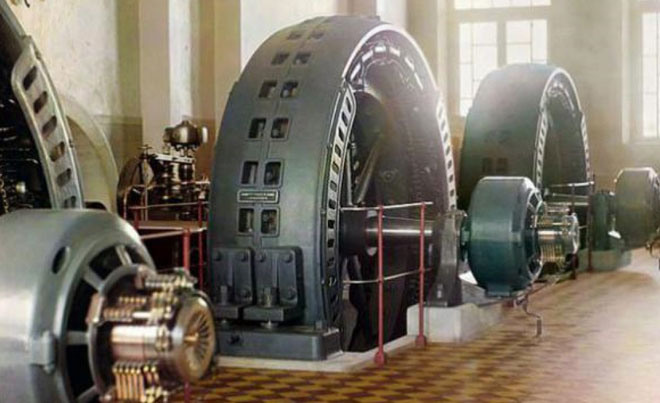
When winding many turns of wire on a coil, the rated voltage increases in proportion to the number of turns. The phenomenon led to the development of generators that provide consumers with electricity. For the effect of the application of a magnetic field, several bobbins are sometimes installed. The stator magnetic field per turn of the rotor is crossed simultaneously by 3 coils, which leads to an increase in the power of the generator. This allows you to power 3 users at once.
What is phase voltage?
In three-phase highways of most states, the voltage size is 220 volts. Phase voltage is measured between the phases at the beginning and end of the wire. In practice, this is the value in the middle of the neutral conductor and the stressed cable. When connected according to the type of star, the values \u200b\u200bof line currents and phase electricity do not differ.
Phase voltage - this is the voltage between the neutral wire and one of the phase wires (220 V).
A symmetrical system excludes the presence of a neutral conductor, with an asymmetric method, the neutral cable maintains proportionality with the source. In the second option, lighting devices are often included in the circuit, and independent functioning of 3 working cables is required, then the receiver outputs are combined in a triangle type.
Interfacial voltage is used in the multi-apartment sector with shops or offices on the ground floors. So you can power trading platforms power cables in order to provide 380 volts. In high-rise buildings, the connection is provided by elevators, escalators, industrial refrigerators. The wiring is relatively simple, given that the housing is zero and lived under load, and 3 working cables and a neutral wire branch off to public premises.
The difference between a three-phase current and a single-phase current is that the network indicator is linear power, and the parameters related to the load are phase voltage. A line is drawn from the station to the consumer, including working conductors and a neutral wire. To reduce leakage when passing through the circuit, converters are installed at the beginning and end of the network, but this does not change the picture. The neutral wire fixes and transports to the user the declared potential received at the output. The power in the wire under load is created based on the value in the neutral.
The magnitude of the phase voltage is detected and occurs relative to the center of the winding connection - the neutral wire. In a three-phase circuit that is symmetrical with respect to loads, a current with minimum values is transmitted through zero. At the output of such a line, the wires under load are painted in generally accepted standard colors:
- core L1 - brown;
- wire L2 - black;
- cable L3 - gray;
- zero braid N - blue;
- yellow or green - provided for grounding.
Such powerful lines are carried out to large consumers - entire microdistricts, factories.For small receivers, a single-phase line is mounted, including a loaded wire and an additional zero. With a uniform distribution of power in single-phase branches, an equilibrium appears in a three-phase design. For laying the component branches, the voltage of the phase of one core relative to the neutral is taken.
What is line voltage?
In a three-phase line, additional voltage can be isolated by connecting a jumper between 2 loaded cables. Its value is higher, since it is a projection onto the plane of coordinates of 2 vectors that make an angle of 120 ° between themselves. The addition to the value of the phase voltage is 73% or calculated as √3-1. The generally accepted line voltage in the power line is always 380 volts.
Line voltage is the voltage between two phase conductors (380 V).
The voltage is calculated between the phases or between their outputs. When installing the circuit, difficulties arise, consisting in inaccuracies in the calculation of the conductor, which sometimes causes an accident. Connection schemes differ in options for combining loaded cores and a source of electricity. Advantages of a single-phase network:
- safety of equipment operation, since the danger in terms of damage comes from 1 cable;
- the circuit is used to implement efficient wiring, select the operating principle, calculate parameters and perform measurements.
Calculations in the system are simple, they are performed taking into account standard physical formulas. A multimeter is used to measure the circuit indicators. The characteristics of the connection to the phase are determined using special voltmeters, current sensors.
Linear voltage occurs when an electric current passes through a submariner when an energy source and receiver are combined. With a decrease in power in the area between the generator output and the consumer, the phase voltage parameters also change. Knowing the linear indicators, it is easy to calculate the value of the phase voltage.
Network features:
- when wiring, professional devices are not required, a screwdriver with a built-in indicator is enough;
- zero is not used when connecting wires - due to the neutral core there is no danger of electric shock;
- the scheme is applicable for permanent networks and lines with alternating current;
- a single-phase connection is made in a three-phase line, but not vice versa.
Use of line and phase voltage
Electric circuits are of direct and alternating current. More often, three-phase AC circuits are used to connect the source of electricity to the consumer. This type of current has several advantages:
- lower energy transmission costs;
- the possibility of creating an electromotive force for the operation of asynchronous equipment (elevators, hoists);
- line voltage and phase voltage can be used simultaneously.
To connect generators in the trunk use the principle of a triangle or a star. In the first version, the windings are connected in series, the beginning of the phase and the end of the other phase are connected. The circuit allows you to increase the voltage several times. In the second case, the initial sections of the windings are combined into a common point, there is no increase in power.
Classification of the electrical network according to the composition of working elements:
- active;
- passive;
- linear;
- non-linear.
Using 4 cables in the trunk, it is possible, by varying the connections, to use both linear and phase currents, which expands the scope. Three-phase lines are considered universal, since a large load is connected, for example, to a 10-volt network. If you connect an appropriate receiver to the line, for example, a three-phase electric motor, then its mechanical power will reach values \u200b\u200bthat are 3 times higher than those of a single-phase unit.
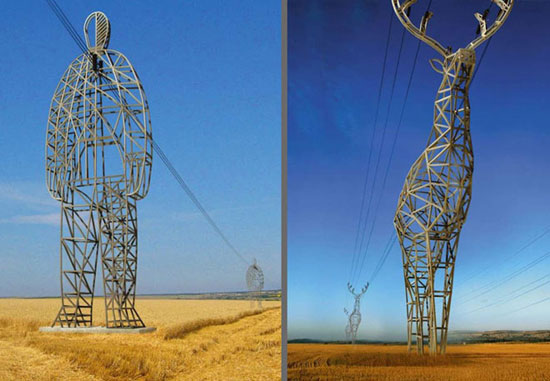
In the multi-apartment sector, the main receivers are household appliances and appliances powered by a 220 V network. Uniform separation between the wires with the load is required, so the apartments are connected in a staggered manner. In private housing construction, the concept of dispersing the load on each cable from all household appliances and equipment has been adopted. The conductor currents transmitted during the switching on of the maximum number of devices are taken into account.
By including identical electric motors in a network with 1 or 3 phases, you can get a difference in the power of its operation. If you additionally choose an effective connection method, then the output indicators will triple. Given the ratio between phase and linear currents, windings should be calculated for increased values. The relative charge difference between loaded wires is always greater than the same value between phase and zero. The main difference between the linear characteristics of voltage and phase power is in the parameters of the resulting voltage.
A classic example of the use of both types of voltage is the connection when installing a three-phase generator. Secondary windings and primary windings are used, connected according to one of the schemes.The relationship between line voltage and phase value in a delta connection helps to equalize the current, and both powers become almost the same. Motors, converters and transformers.
The star option involves connecting the contacts of all windings to one circuit using jumpers. The conductors carry a current with the indicators of this network, and the voltage is transmitted to the active outputs and contacts.
Similar articles:
